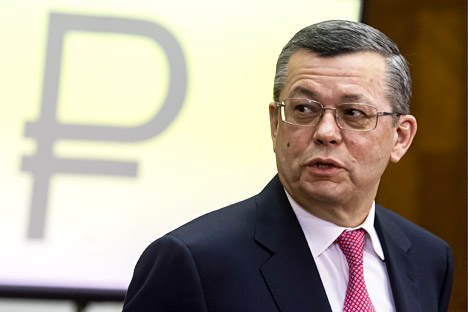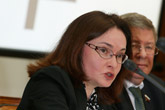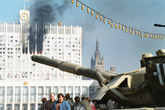Russian ruble gets a new symbol

The official logo of the Russian ruble was announced on Dec.11. Source: ITAR-TASS
The symbol of the ruble was not simply introduced, but chosen by Russian Internet users during an online poll. The Bank of Russia conducted the month-long poll, during which more than 280,000 votes were cast.
In the end, the winning symbol received 61 percent of the votes, beating out four other designs. This symbol will represent Russian ruble in exchange offices and on price signs both inside and outside Russia.
During its 700-year history, the ruble was never officially used in other countries until recently, when free circulation of the ruble was first introduced in the Chinese city of Suifenhe, just near the Russian-Chinese border.
The Chinese government’s decision allows residents in the city to hold accounts in both yuans and rubles, and both currencies are equally accepted in shops and during cashless settlements.
This decision has institutionalized the practice common for this region since the 90s – Suifenhe is a hot spot for Russian and Chinese shuttle traders, as well as tourists from Russian East, who come here loaded with rubles.
Other countries frequented by Russian tourists, like Portugal, Bulgaria, and Montenegro, may also open their doors to ruble in the near future. With the Russian ruble poised to become more international, a few crucial moments of its history are worth examination.
In early medieval Russia mining was yet unknown, so to produce exchange medium, foreign silver was used – small foreign coins were used for cheap trade, and large quantities were melted into bars that began to be called rubles in the late 13th century.
The word “ruble” can be roughly translated as “one having a seam” – and, naturally, those silver bars could be distinguished by a post-casting seam. As rubles were very expensive (you could buy a herd of cows for a ruble), few people possessed them – casual payments were mostly made in small coins of foreign currencies.
Only under Peter the Great, in 1704, first original Russian ruble coins were finally emitted. Also, Peter was the first to introduce decimal coinage, that later was adopted by most monetary systems of the world.
But along with coins, forgery set in, so in the 18thcentury, all sorts of attempts to prevent it were made, including, for example, production of a giant copper ruble 7.5 centimeters in diameter and 3.5 centimeters thick, weighing a kilogram – that rare coin, that was never widely used, was last auctioned in 2003 for a price of $80,000.
As the financial needs of the state increased, banknotes were introduced. Initially, they were well secured, but extensive emission quickly made their cost sink. In the 19th century, two standards came to exist – one could pay either a silver ruble or approximately three to four rubles in banknotes for the same thing, a peculiarity widely reflected in Russian literature.
In “Ardent Heart”, a play by Russian dramatist Alexander Ostrovsky, a merchant promises to pay 100 silver rubles for the brawl he started, and eventually gives away 300 rubles in banknotes. Important payments among the nobility (including card debt payments, which were to be made in time to preserve a nobleman’s honor) were made in silver rubles.
Related:
China reportedly planning to back the yuan with gold
Liberal Democrats want to confiscate Russians’ dollars
No alternative for the current economic system
Russia's foreign policy: Balancing at the backdrop of U.S.-China rivalry
Ironically enough, Russia even emitted platinum rubles in 1828, after platinum was discovered in the Urals, but at the time, the unique properties of this metal were unknown, so it was considered much cheaper than silver or gold.
The golden ruble also existed for a short time between 1897 and 1914, after the monetary reform, which for the first time in Russian history made the ruble an internationally competitive currency.
But after the Revolution, sheer monetary chaos broke loose. At first, the Bolsheviks naively planned to abolish money in general, which, of course, was infeasible. Meanwhile, during the Russian Civil War, emissions of local surrogate currencies began in different parts of the country.
Banknotes in Arkhangelsk region bore the image of a walrus; in the Russian East, ruble banknotes were emitted by a Japanese merchant Gentaro Shimada, Khan of Khiva began printing banknotes on silk, and in Yakut region, that was short of paper, banknotes were printed on wine labels from a private collection of a local official.
All such banknotes were losing their value by leaps and bounds, so only a few years later people could use them as wallpaper or wrapping material. Only in 1923, the ruble was reintroduced as national currency again – although during the Soviet rule, three major monetary reforms were performed to support ruble’s rate.
In 1992 to 1993, the new Russian ruble was emitted, establishing contemporary monetary system. However, in this system, the ruble was a lot cheaper than even in Soviet times – in 1996, even the poorest Russians counted their money in thousands and millions of rubles – a tram fare was a 1,000 rubles, a newspaper 800 rubles; U.S. dollar cost between 5,000 to 6,000.
During the 90s, Russians started calling ruble “derevyannyi” (a wooden one), meaning that, on the contrary to expensive pre-revolutionary golden ruble, the contemporary ruble is worth no more than a piece of wood.
In 1997 to 1998 during the economic crisis, the ruble was denominated by hundreds and banknotes re-emitted, which gave birth to the current Russian ruble. Although not yet very high-priced on the world market, the ruble has good perspectives to become a popular convertible currency, and the new symbol surely contributes to this cause.
All rights reserved by Rossiyskaya Gazeta.
Subscribe
to our newsletter!
Get the week's best stories straight to your inbox


